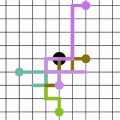We study an elementary Markov process on graphs based on electric flow sampling (elfs). The elfs process repeatedly samples from an electric flow on a graph. While the sinks of the flow are fixed, the source is updated using the electric flow sample, and the process ends when it hits a sink vertex. We argue that this process naturally connects to many key quantities of interest. E.g., we describe a random walk coupling which implies that the elfs process has the same arrival distribution as a random walk. We also analyze the electric hitting time, which is the expected time before the process hits a sink vertex. As our main technical contribution, we show that the electric hitting time on trees is logarithmic in the graph size and weights. The initial motivation behind the elfs process is that quantum walks can sample from electric flows, and they can hence implement this process very naturally. This yields a quantum walk algorithm for sampling from the random walk arrival distribution, which has widespread applications. It complements the existing line of quantum walk search algorithms which only return an element from the sink, but yield no insight in the distribution of the returned element. By our bound on the electric hitting time on trees, the quantum walk algorithm on trees requires quadratically fewer steps than the random walk hitting time, up to polylog factors.
翻译:我们根据电流抽样(elfs)在图表上研究一个基本的Markov进程。 精灵过程反复从图表上的电流中采集样本。 虽然流的汇是固定的, 源是使用电流样本更新的, 当它击中一个水槽的顶点时, 过程结束。 我们争论说, 这个过程自然地连接到许多关键的利益量。 例如, 我们描述一个随机的行走混合法, 这意味着精灵过程的到达分布与随机行走分布相同。 我们还分析了电动打击时间, 这是该过程击中一个水槽顶点之前的预期时间。 我们的主要技术贡献显示, 电动袭击树木的时间是图形大小和重量的对数。 精灵过程的最初动机是量子行走可以从电流中采集样本, 因此它们可以非常自然地执行这个过程。 这可以产生一种从随机行走抵达分布中取样的量行走算法, 并且具有广泛的应用性。 我们还分析了现有的量漫行搜索算算法线, 它只是从水槽返回一个元素, 但没有在图表中进行洞察, 。 我们的主要技术贡献显示, 树上的电击时间在图形大小和重量的分布上, 。 需要在返回的电流中, 方向上, 。





